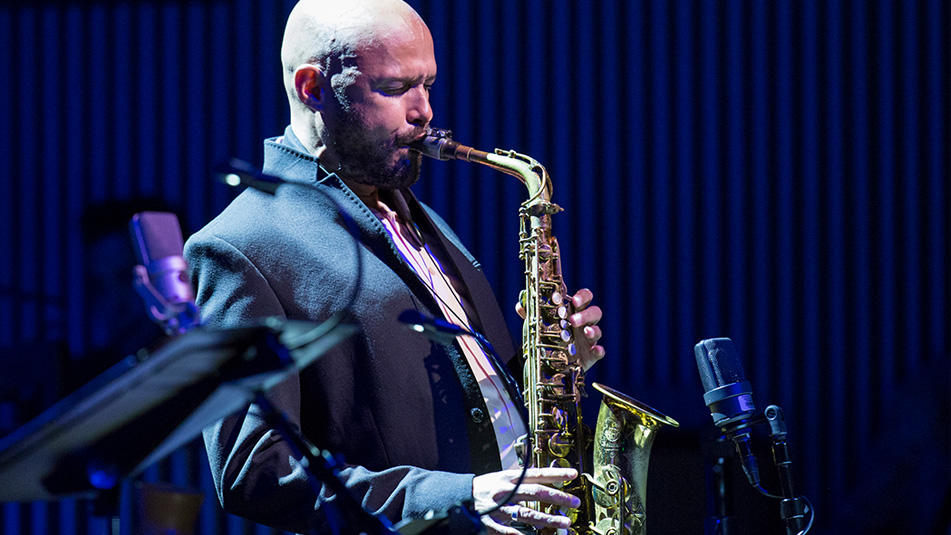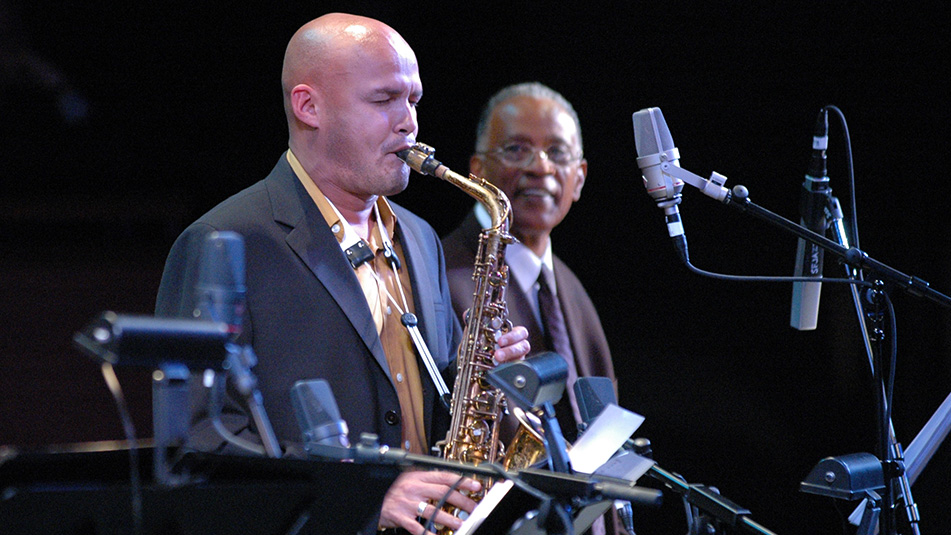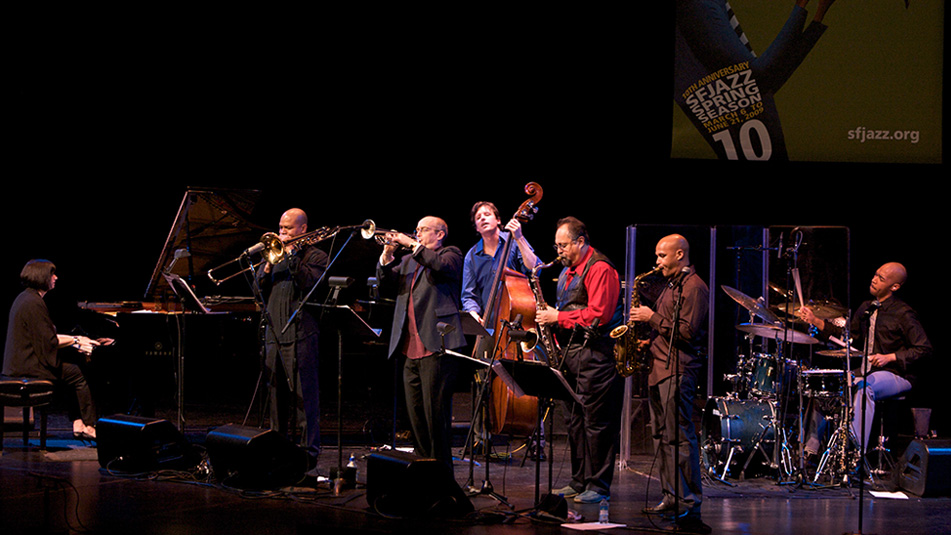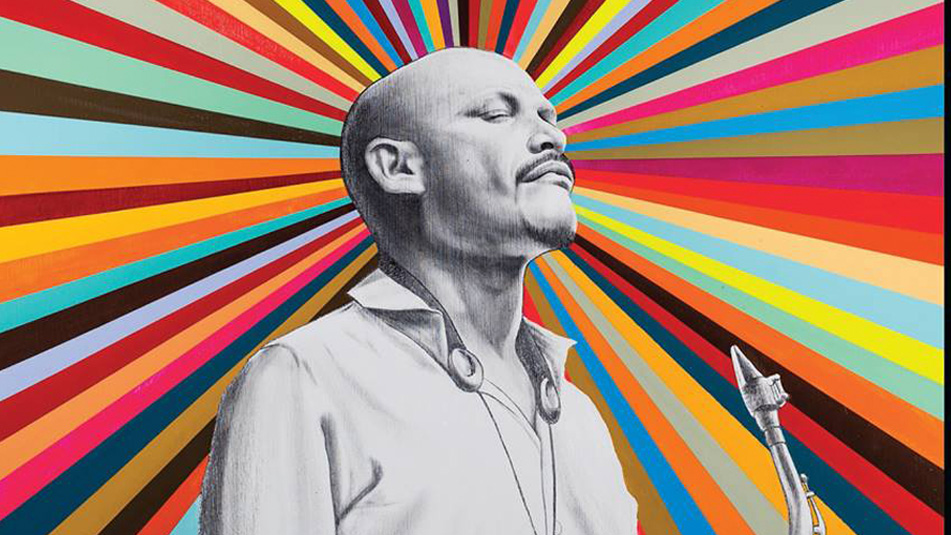End Of An Era: A Retrospective of Miguel Zenón's 14 Years With The SFJAZZ Collective
October 15, 2018 | by Jesse Hamlin

Miguel Zenón plays with the SFJAZZ Collective (Scott Chernis, 2016)
A tribute to founding member Miguel Zenón, who enters his final year with the SFJAZZ Collective, Miguel Zenón Retrospective is an exclusive limited edition double CD that's a collection of Miguel’s original compositions, written over his fourteen-year career with the band.
Miguel Zenón had the late, great Bobby Hutcherson very much in mind when he composed “Lingala,” his first piece for the SFJAZZ Collective, written in 2004 for the first incarnation of the celebrated octet whose members have included some of jazz’s most compelling and creative voices. Inspired by a balafon melody Zenón heard on the streets of Kinshasa, the music builds hypnotically from an ostinato introduced by Hutcherson. Playing over that joyous polyrhythmic piece at the first rehearsal, the master vibraphonist offered a suggestion: he’d bring in his marimba to deepen the sound.
“I'll play that ‘A’ way down and it’ll sound like a big ol’ hollow log,” Hutcherson told Zenón, who was thrilled to be working with the revered improviser, the linchpin of the ensemble in its early years.
Over the ensuing 13 seasons, the passionate Puerto Rican alto saxophonist and composer would create a rich body of rigorous, expansively expressive works that reflected the particular artists in the Collective at the time – whether it was tenor saxophonist Joe Lovano, trombonist Robin Eubanks or trumpeter Avishai Cohen – and his own development as a composer and orchestrator.
A modest gent with a keen mind and imagination, Zenón professes no favorites among the far-ranging pieces he’s composed for the Collective, 11 of which comprise this bountiful retrospective of his original music for the band. But he has a special feeling for “Lingala.”
“It was the first piece I wrote the band, and it opened a door,” says Zenón, who considers the Collective the most important musical experience of his life. “It represents a new chapter for me.”

Miguel Zenón and Bobby Hutcherson performing with the SFJAZZ Collective in 2005
That chapter comes to an end when the saxophonist leaves the band after the 2018-19 season. Fittingly, “Lingala” opens this two-CD set celebrating Zenón’s contribution to the Collective. It showcases the intricate and dynamic pieces he wrote for various editions of the octet, whose unusual instrumentation – four horns, vibes, piano, bass and drums – he consistently employs in fresh, sonically rich ways.
Miguel Zenón's Farewell Concert w/ the SFJAZZ Collective is October 21 at the SFJAZZ Center.
In these multilayered, time-shifting pieces, which balance precisely detailed written parts with unbounded solo, duo and group improvisations, you hear fierce angular lines and hymn-like chorales (variously used in tunes like “Life at the End of the Tunnel” and “Grand Opening”); gale-force propulsion and popping horn riffs (“No Filter”); sumptuous harmonies that swell and fade beneath the soloist, and overlapping patterns that ripple like waves (“The Mystery of Water”) or seemingly echo in the distance (the lovely “More to Give,” written by Miguel for his wife, Elga).
“The Collective has been hugely important to me in every way,” says Zenón, whose fervent playing and compositions have been central to the band’s sound. “I’ve gotten the chance to play with some of the greatest players out there, and some of my heroes. That’s something I will treasure forever. I’ve grown so much from the experience. Writing so much music for the ensemble really helped me find my own voice as a composer. Every year I had to figure out, ‘What haven’t I done yet that I can try this year?’ Every piece represents something different in my development as a writer.”
Like many jazz composers from Ellington on, Zenón writes for the specific voices of the musicians in the group. Pieces like the three- part “Synthesis of a Band” from 2014 were actually built on musical ideas that his improvising bandmates had played with apparent pleasure. (David Sánchez in the case of Part I, Eubanks for Part 2, Cohen for Part 3).
“All these musicians have strengths, and you to try exploit their strengths when you write for them,” says Zenón, a 2008 MacArthur Foundation “genius” grant recipient. “When you’ve played with the same folks for a few years, you know what they’re about and it affects the writing.”
He mentions drummer Obed Calvaire, who joined the Collective in 2013 and helped inaugurate the SFJAZZ Center that year. “He’s one of the hardest working musicians I’ve ever met. So I know I can stretch it pretty far in terms of what I write for him, because he’s going to put in the time to get it to where I’m trying to get it.” When Joe Lovano and Dave Douglas were in the band in 2008 and ’09 – heard in this collection on “Frontline” and “No Filter” – “I was feeding on that freer energy they have when they play their music.”

SFJAZZ Collective, 2009
Many Zenón pieces start with a non-musical idea, a system or set of parameters to build on. For “Grand Opening,” written in celebration of the SFJAZZ Center’s opening and premiered and recorded in its acoustically pristine auditorium, he studied the structure’s blueprints and used its dimensions as his musical building blocks. The 2005 Collective, which featured five founding members (Zenón, Hutcherson, Joshua Redman, Nicholas Payton and Renee Rosnes), drummer Eric Harland and bassist Matt Penman, brought forth Zenón’s “2 and 2,” whose melody, meters and harmonic structures were based on the number 22 and those that divide it evenly - 11, 2, 1.
“I like to draw out of non-musical ideas, and translate them into something that can be used musically,” the composer explains. “Usually it’s something related to numbers or some kind of system. It just speaks to me to do it that way. I don’t feel comfortable starting out of randomness, and just waiting for inspiration. I feel more comfortable with something that’s concrete and specific, and when I sit down to write the piece, I already have a direction.”

Artist Ian Johnson's album art for the SFJAZZ Collective's Miguel Zenón Retrospective album
When you have a lot of instruments at your disposal, he adds, “there’s the risk you can overwrite. I’ve really tried to work on being more economical, and making things more interesting in terms of timbre and orchestration, dealing with pairings and using different instruments in different ways.”
His colleagues appreciate that. Pianist Edward Simon, a Collective member since 2010, says Zenón “brings a certain kind of edge to the band. His compositions and arrangements being among the most challenging, creative and forward thinking, have set a high bar for the group over the years.” Simon praises the saxophonist’s improvisational gifts – “he’s an amazing player with impeccable chops who takes chances” – and his writing.
“Miguel’s music is often very complex, especially rhythmically. He’s usually working with complex cycles, varying time signatures and metric modulations. However, in the midst of all the complexity there is always a strong, sing-able melody. I think this is what makes his music effective and accessible to the listener. He knows how to tell a story.”
After dedicating a big chunk of time and energy to the Collective all these years, Zenón wants to focus on writing for his group and spending more time with his family.
“I’m going to miss the fellowship, and being part of the jazz center, but I’m sure the relationship there is going to continue,” he says. “What I’m going to miss most is the process of putting all this music together – the rehearsals, seeing the music grow from nothing into a full-blown piece, and that piece becoming part of a set in performance. That gives me the most satisfaction.”
